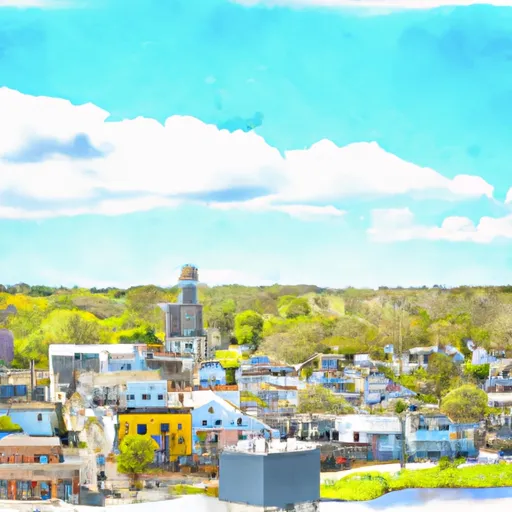-
 Snoflo Premium
Snoflo Premium
Get unlimited access to all our content
With no Ad interruptions! - Start Your Free Trial Login with existing account
Wolcott
Eden Index
Climate
8.4
•
Recreation
4.9
•
Community
3.0
•
Safeguard
5.8/10

Wolcott, Connecticut is a charming town located in New Haven County. The climate in Wolcott is classified as humid continental, with four distinct seasons. Summers are typically warm and humid, with average temperatures ranging from the mid-70s to low 80s Fahrenheit. Winters can be cold, with temperatures often dropping below freezing, and snowfall is common.
The hydrology constituents of Wolcott are influenced by several bodies of water, including Scoville Reservoir and Mad River. These water sources provide opportunities for activities like fishing, boating, and kayaking. Scenic hiking trails line the banks of the Mad River, offering picturesque views and a chance to explore nature.
Outdoor recreation opportunities in Wolcott extend beyond water activities. The town boasts numerous parks and green spaces, perfect for picnicking, playing sports, or enjoying a leisurely stroll. Woodtick Recreation Area offers amenities such as tennis courts, basketball courts, and a playground. Peterson Park features baseball fields, soccer fields, and a skate park, catering to sports enthusiasts.
Overall, Wolcott, Connecticut offers a pleasant climate, picturesque hydrology constituents, and a range of outdoor recreation opportunities for residents and visitors alike.
What is the Eden Index?
The Snoflo Eden Index serves as a comprehensive rating system for regions, evaluating their desirability through a holistic assessment of climate health, outdoor recreation opportunities, and natural disaster risk, acknowledging the profound impact of these factors on livability and well-being.
Climate Health Indicator (CHI): 8.4
Wolcott receives approximately
1358mm of rain per year,
with humidity levels near 78%
and air temperatures averaging around
9°C.
Wolcott has a plant hardyness factor of
6, meaning
plants and agriculture in this region thrive during a short period during spring and early summer. Most
plants will die off during the colder winter months.
By considering the ideal temperature range, reliable water supplies, clean air, and stable seasonal rain or snowpacks, the Climate Health Indicator (CHI) underscores the significance of a healthy climate as the foundation for quality living.
A healthy climate is paramount for ensuring a high quality of life and livability in a region, fostering both physical well-being and environmental harmony. This can be characterized by ideal temperatures, reliable access to water supplies, clean air, and consistent seasonal rain or snowpacks.
Weather Forecast
Streamflow Conditions
Connecticut Coastal
Area Rivers
Connecticut Coastal
Snowpack Depths
Connecticut Coastal
Reservoir Storage Capacity
Connecticut Coastal
Groundwater Levels
Recreational Opportunity Index (ROI): 4.9
The Recreational Opportunity Index (ROI) recognizes the value of outdoor recreational options, such as parks, hiking trails, camping sites, and fishing spots, while acknowledging that climate plays a pivotal role in ensuring the comfort and consistency of these experiences.
Access to outdoor recreational opportunities, encompassing activities such as parks, hiking, camping, and fishing, is crucial for overall well-being, and the climate plays a pivotal role in enabling and enhancing these experiences, ensuring that individuals can engage in nature-based activities comfortably and consistently.
Camping Areas
| Campground | Campsites | Reservations | Toilets | Showers | Elevation |
|---|---|---|---|---|---|
| Wildwood State Park | None | 121 ft | |||
| Tolland State Forest | 93 | 1,473 ft | |||
| Granville State Forest | 22 | 1,135 ft | |||
| Chester - Blanford State Forest | 12 | 516 ft | |||
| Cathedral Pines County Park | None | 99 ft | |||
| Black Rock State Park | 100 | 399 ft | |||
| Haws Memorial - American Legion State Forest | 30 | 534 ft |
Nearby Ski Areas
Catastrophe Safeguard Index (CSI):
The Catastrophe Safeguard Index (CSI) recognizes that natural disaster risk, encompassing floods, fires, hurricanes, and tornadoes, can drastically affect safety and the overall appeal of an area.
The level of natural disaster risk in a region significantly affects safety and the overall livability, with climate change amplifying these risks by potentially increasing the frequency and intensity of events like floods, fires, hurricanes, and tornadoes, thereby posing substantial challenges to community resilience and well-being.
Community Resilience Indicator (CRI): 3.0
The Community Resilience Indicator (CRI) recognizes that education, healthcare, and socioeconomics are crucial to the well-being of a region. The CRI acknowledges the profound impact of these elements on residents' overall quality of life. By evaluating educational resources, healthcare accessibility, and economic inclusivity, the index captures the essential aspects that contribute to a thriving community, fostering resident satisfaction, equity, and social cohesion.

